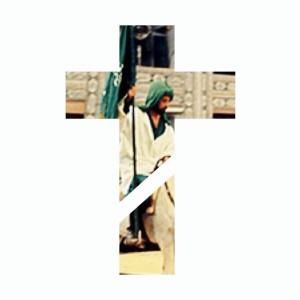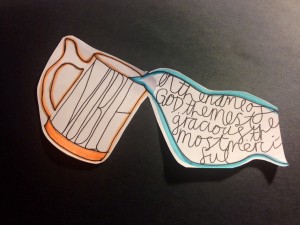“Hussein’s Martyrdom,” Week 5: Theology through Drama
Shi’i ritual involves commemorating and participating in the suffering of the Shia Imams who are the physical descendants of the Prophet Muhammad through Ali and Fatima. The “t” shape of this image I edited stands for “taziyeh,” which is a ritual drama depicting the siege at Karbala. The nucleus of the taziyeh, as emphasized by Chelkowski, is the heroic martyrdom of Hussein, the grandson of the Prophet. The image of the man in the “t” above comes from one of Chelkowski’s pictures of a man playing Hussein in an actual taziyeh performed in Iran. Hussein is preparing to confront death in order to save all believers. Therefore, the “t” is also meant to represent a cross, relating Hussein’s death to the crucifixion of Jesus whose life was sacrificed on behalf of all believers in God. So here we see a similarity in the interpretation and conceptualization of death as something sacred and prized for those who have followed a path of righteousness; thus, we draw a parallel between Christian and Shi’i tradition which interpret events of violence and suffering in terms of redemption and voluntary sacrifice.
“Digressions or Guriz were introduced to extend the scope of the Ta’ziyeh and to add variety and secular detail. These were based on episodes from Biblical or Koranic stories, and from national legend and tradition. Spectators were led to identify their own sufferings with those of these lesser heroes. For women especially, they served as a wound-healing agent, for the point was always made that all suffering was slight when compared to that of the victims of Kerbela.” –Peter Chelkowski, Taziyeh: Ritual and Drama in Iran.
Taziyeh, in fact, means expressions of sympathy, mourning and consolation. In seeing the brutal suffering of the most righteous, those being the Imams and specifically Hussein, spectators are led to sympathize with and mourn for them. Suffering and death of the martyrs of Karbala were instruments of redemption for all believers. Participation in taziyeh dramas, whether as an actor or an audience member, was an aid to salvation as Shi’ites believed that participants would gain Hussein’s intercession on the day of the Last Judgement. Thus taziyeh involves dynamic interaction between actors and the audience; the purity of this interaction is based on their common humanity and creates an inner harmony.


